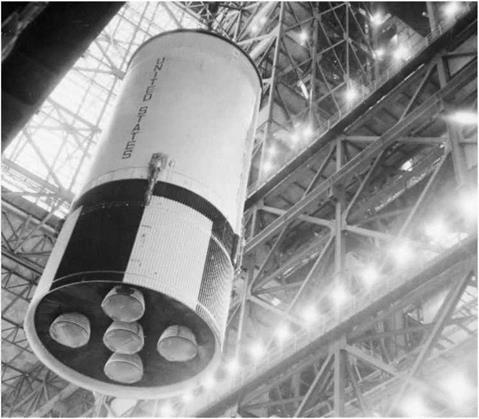The second stage: S-II – A difficult birth
The S-II (pronounced s-two) stage was the last of the Saturn’s three stages to be developed, and while the other two stages faced formidable engineering problems, neither caused the kind of headaches that the S-II gave managers at NASA and
|
|
Apollo 12’s S-IVB stage during transportation operations on a Super Guppy aircraft,
(NASA) " "
North American Aviation, the company that won the contract to build it. The stage not only had to carry cryogenic propellants, it was large. It matched the 10-metre diameter of the S-IC and was nearly 25 metres long. Additionally, because the other two stages were much further along in their design cycles, any demands for reductions in mass tended to be made of the S-П. The decreasing mass of the stage during development led to the inadvertent destruction of two stages in ground testing and, for a while, the S-II became the pacing item in the race for the Moon. Indeed, in the wake of the Apollo 1 tragedy, scathing reports on the management style of North American – which was also building the Apollo spacecraft – came close to ending the Apollo programme.
At first glance, the S-II is like a very large S-IVB, as both shared the same basic tank design utilising a common bulkhead. However, North American chose to save further weight by fabricating the tank walls from metal alloys that actually gained in strength when chilled by liquid hydrogen. This meant that insulation would be added to the outside and the adhesive had to work at 20 К. Initially, engineers used panels of honeycomb filled with polyurethane foam. They then found that gaps between the insulation and the tank wall caused the air within to freeze and the panels to loosen or fall off. Eventually, an arrangement of grooves within the insulation was implemented which was purged with helium (which would not freeze) while fuel was being loaded. This proved unsatisfactory, and starting with the S-II for Apollo 13, a spray-on foam was directly applied to the tank walls which not only provided improved insulation but also saved on weight and cost and eliminated the helium purge.
Power for the S-II came from five non-restartable J-2 engines which produced a
|
Apollo 10’s S-II stage about to be stacked as part of the launch vehicle. (NASA) |
combined thrust that could balance 520 tonnes. As with the S-IC, the stage was steered by commands which swivelled the four outboard engines.












